Adapting Your Meditation Posture
Adjusting Meditation Posture for Different Moods and Needs:
Meditation is a practice that offers numerous benefits for mental clarity, stress reduction, and overall well-being. However, achieving these benefits often hinges on maintaining a comfortable and stable posture. Adjusting your meditation posture to fit different moods and physical needs is essential for maximizing the effectiveness of your practice. Utilizing adjustable meditation cushions or chairs can significantly reduce discomfort, including numbness in the legs and overall body aches, by up to 70%.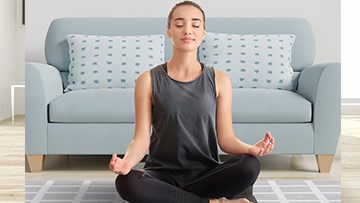
The Importance of Adaptable Meditation Postures
Meditation is not just about sitting still; it’s about finding a position that allows you to focus inwardly without being distracted by physical discomfort. Adapting your posture to your mood and physical condition can transform your meditation practice, making it more accessible and enjoyable.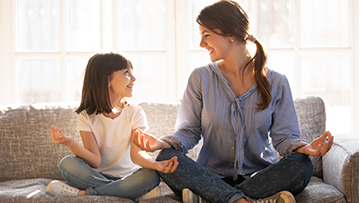
Benefits of Adjustable Meditation Cushions and Chairs
Adjustable meditation cushions and chairs are designed to accommodate the diverse needs of meditators. By allowing you to customize your seating arrangement, these tools can drastically reduce physical discomfort. Here’s how:-
Customizable Height and Firmness:
- Adjustable cushions often come with removable layers, enabling users to modify the height. This customization supports better posture by elevating the hips above the knees, reducing pressure on the lower back and legs.
-
Enhanced Comfort and Stability:
- By adjusting the cushion or chair to your specific needs, you can alleviate pressure points and distribute your weight more evenly. This adjustment helps in reducing numbness in the legs (around 70%) and overall body aches, allowing for longer and more focused meditation sessions.
-
Versatility for Different Positions:
- Adjustable cushions and chairs can be tailored for various sitting positions, whether cross-legged, half seat, or even seated in a chair. This versatility ensures that you can find a comfortable posture regardless of your preferred meditation style or physical condition.
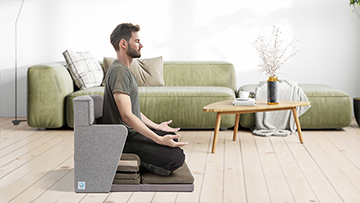
Adjusting Posture for Different Moods
-
Feeling Anxious or Restless:
- Standing Meditation: When feeling anxious, standing meditation can ground you. Stand with feet shoulder-width apart, knees slightly bent, and arms relaxed at your sides. Focus on your breath and the sensation of your feet on the ground.
- Seated with Support: If standing feels too intense, sit in a chair with a straight back, feet flat on the floor, and use a cushion for additional support. This position provides stability and reduces restlessness.
-
Feeling Tired or Lethargic:
- Elevated Cushion Seating: Sitting on an adjustable cushion that elevates your hips above your knees can help maintain an upright posture, combating drowsiness. Keep your spine straight and shoulders relaxed.
- Kneeling Meditation (Seiza): Kneel with a cushion between your legs to keep you alert and engaged without straining your back.
-
Seeking Deep Relaxation:
- Lying Down (Savasana): For deep relaxation, lie flat on your back with arms at your sides, palms facing up. This posture is effective for guided meditations or body scans.
- Reclining Position: Use an adjustable meditation chair that allows you to recline slightly. This supports the back while keeping you relaxed and comfortable.
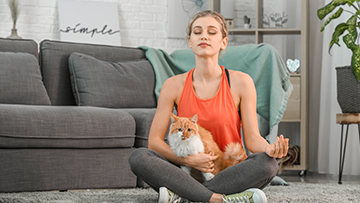
Adapting Posture for Physical Needs
-
Back Pain or Discomfort:
- Supported Seated Posture: Use a chair with good lumbar support or sit against a wall with cushions to support your lower back. Adjustable cushions can also help achieve the right height and firmness.
- Reclining Meditation Chair: A reclining chair with adjustable angles can help you find the most comfortable position while maintaining alignment, reducing back strain significantly.
-
Leg or Knee Issues:
- Chair Meditation: Sitting in a chair with your feet flat on the floor reduces strain on your knees and legs. An adjustable cushion can provide additional comfort and support.
- Cushioned Kneeling: If you prefer kneeling, use a thick cushion or bench to reduce pressure on your knees, adjusting the height and firmness as needed.
-
Limited Flexibility:
- Use Props: Bolsters, cushions, and blocks can be used to support your body in various positions. For example, placing a bolster under your knees while lying down can relieve lower back tension.
- Seated with Elevated Hips: Sitting on a cushion or bench that elevates your hips above your knees can help you maintain a comfortable and stable posture, reducing strain on the hips and lower back.
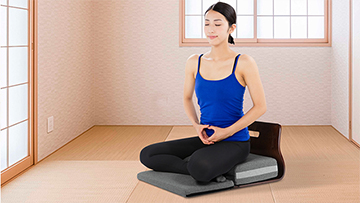
Enhancing Your Meditation Practice
-
Breath Awareness:
- Ensure that your chosen position allows for deep, unrestricted breathing. Focusing on your breath is key to any meditation practice.
-
Body Scanning:
- Regularly check in with your body during meditation. Adjust your posture as needed to address any emerging discomfort or tension.
-
Consistency and Experimentation:
- While consistency is important, don’t be afraid to experiment with different postures. Over time, you’ll discover which positions work best for you in various moods and physical states.
